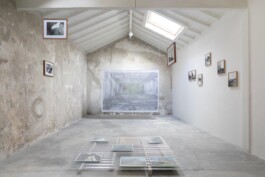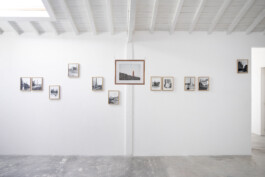








On towers and groves:Remnants of the fordian city by Jiôn Kiim
25.11.2022 – 11.01.2023
The landscape of the contemporary city is a composition of architectural and geological stratta that tells the story(ies) of that city. Through a photographic drift, On towers and groves focuses on a particular layer: the remnants of the fordian city. Jiôn Kiim has been conducting photographic research on industrial ruins in Greater Porto in search of the specific temporality of that dereliction, and the suspension of hectic contemporary rhythms. After her first encounter with Ford Palace in 2015, the artist continued to come upon abandoned factories, until eventually starting photographing them. In 2018 she worked in collaboration with Artur Leão to publish the book Fendas Intemporais / Timeless Cracks (Scopio Editions) and later it was reedited and published for scopio newspaper #6 in 2021. More recently, the artist noted the increase of ruins that have been demolished or obstructed, due to security reasons, or because new real estate developments are about to bring a new functionality to these spaces.
On towers and groves is the result of a new methodology. Leaving behind the map that used to guide her, Jiôn Kiim drifted throughout the city, following the clues that appeared in the sky. The artist found curious juxtapositions of imponent towers over contrasting backgrounds. In many cases, these towers – brick industrial chimneys – are the last remnants of old factories of the XIXth and first half of XXth centuries. With the development of distribution and transportation networks, industries moved to peripheral parts of the city. Once their productive function was over, they became protected industrial heritage, abandoned and useless, they became monuments. Photographing the towers amid the buildings erected meanwhile, the artist captures the absurdity of these compositions and what their patrimonization might represent: in some cases, the fetichist valorization of real estate developments; in others, the cristallization on collective memory of this historical epoch; in others still, the spectrality of the contrast between the industrial impetus and the terrain vague.
In the second movement, the drift crosses the groves of untilled ruins. Abandoned, they become fertile land, the vegetation grows wildly, and they become habitat to particular forms of life. The orderly pulsion of the city can’t go through the enchantment that protects these places. In their invisibility and discretion, they host a multiplicity of practices that the city tends to make invisible. Here some find shelter in times of need, others find open surfaces for their artistic expression, or leave food for hiding cats. In these spaces, and in the images she collects, the artist engages in a momentary interruption of the excessive positivity that defines contemporary society. As Byung-Chul Han suggests, the exploitation imposed in the past by way of disciplinary working methods invented by the factories is now exercised through over-positive and restless pleasure-driven impositions, affecting our social relations and our self-representation. The groves are places of suspension of those drives and, therefore, places of regeneration of the city.
Maybe we can only find shelter from the diffuse generalized universal industrialization – that Ernest Mandel opposes to the idea of a post-industrial society – in the decadence and ruination of actual factories. And maybe we can find some irony in the fact of the artist returning to these spaces to “produce” photographs that transform the improductive place into something productive. The recent history of cities reinforces Rosalind Krauss’s lesson (after Jameson): by proposing “a Utopian alternative to, or compensation for, a certain nightmare induced by industrialization or commodification, [the artist] is at the very same time projecting an imaginary space which, if it is shaped somehow by the structural features of that same nightmare, works to produce the possibility for its receiver fictively to occupy the territory of what will be a next, more advanced level of capital.” In this project, the paradox doesn’t solve itself, but Jiôn Kiim essays to overcome the contradiction and produce a pharmakon capable of curing its own venomous effects. Her choice of media, analogue photography, involved the artist in the production of photograph prints through the whole process – until the development of each copy of each photo (in the case of the black and white images) in the darkroom. Its manuality, its specific temporality, but, above all, the ritualistic repetitiveness of the production of images place this practice in redemptive contradiction with contemporary flows.
This exhibition documents the path taken by the artist: a collection of towers in different urban contexts guides the drift, eventually opening into the groves. Through these movements of sighting and immersion, Jiôn Kiim directs our attention to the absurd collages that emerge with the passage of time, to temporalities that contrast with the flow of urbanization, and to the processes of transformation of the city.
Text and curation by João Pedro Amorim
The project has a book with the same name, which can be purchased here
